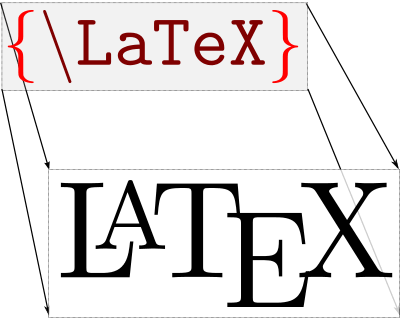This is a guide to the LaTeX typesetting system. It is intended as a useful resource for everybody, from new users who wish to learn, to old hands who need a quick reference.
TeX and LaTeX
TeX is a typesetting computer program created by Donald Knuth, originally for his magnum opus, The Art of Computer Programming. It takes a "plain" text file and converts it into a high-quality document for printing or on-screen viewing. LaTeX is a macro system built on top of TeX that aims to simplify its use and automate many common formatting tasks. It is the de-facto standard for academic journals and books, and provides some of the best typography free software has to offer.
This book is organized into different parts:
- Getting Started will provide you with the very first steps to print your first document, from installing the needed software to basic concepts and syntax.
- Common Elements discusses common features you would expect from a document processor, including fonts, layout, colors, lists, and figures.
- Mechanics are some topics that are not really necessary to write a basic document, but could help you understand how some parts of the system work. These topics are required for fine-tuning documents. Use them as support for various chapters, as they are often being referred to.
- Technical Texts focuses on different specialized matters, mostly for scientific work.
- Special Pages is for the structured pages usually put in appendices.
- Special Documents: this part tackles other kind of documents different from the classic article style.
- Creating Graphics is for the process of writing graphics from a LaTeX document.
- Programming or how to create your own macros and packages.
- Miscellaneous contains everything that does not fit in the previous parts, like project management and other subjects related to LaTeX but not inherent to LaTeX itself.
- Help and Recommendations : the FAQ encompasses very common pitfalls and important recommendations for everyone, we urge you to read it; the Tips and Tricks are much more specific matters.
- Appendices.
Contents

If you have questions related to LaTeX, ask at the Q&A.
- Getting Started
- Common Elements
- Document Structure
- Text Formatting
- Paragraph Formatting
- Colors
- Fonts
- List Structures
- Special Characters
- Internationalization
- Rotations
- Tables
- Title creation
- Page Layout
- Customizing Page Headers and Footers
- Importing Graphics
- Floats, Figures and Captions
- Footnotes and Margin Notes
- Hyperlinks
- Labels and Cross-referencing
- Initials
- Mechanics
- Technical Texts
- Special Pages
- Special Documents
- Creating Graphics
- Programming
- Miscellaneous
- Help and Recommendations
- Appendices
Other wikibooks
This article is issued from
Wikibooks.
The text is licensed under Creative
Commons - Attribution - Sharealike.
Additional terms may apply for the media files.